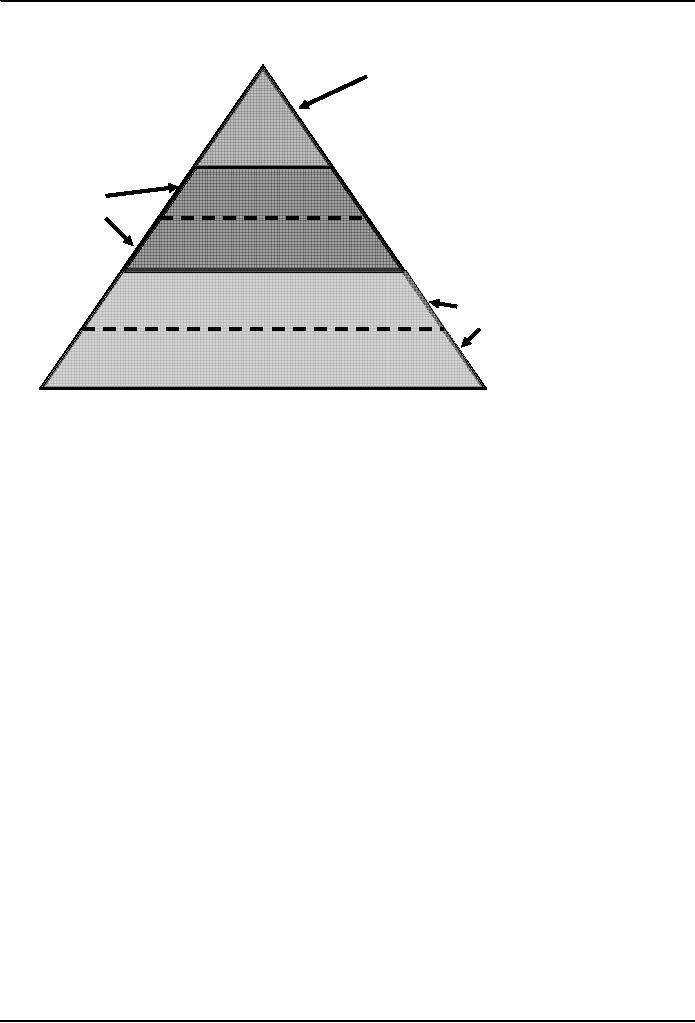 |

Conflict
Management HRM624
VU
Lesson
15
INTEREST
ANALYSIS II
Quotations:
It is
easier for a camel to pass
through the eye of a needle if it is
lightly greased.
Kehlog
Albran
I do
not love the money. What I
do love is the getting of it...What other
interest can you suggest to
me? I
do not
read. I do not take part in
politics. What can I
do?
Philip
D. Armour (1832 - 1901) U.S.
business executive
Interpretation:
Philip
may like to gift away
money but will probably
not like to let any
body else win in a
business
conflict. Deeper interest
here is the personal success of an
individual in a negotiation.
Principles
and values
Conflict
participants have underlying principles
and values at play in their
motivations.
Disputants
may express principles and
values disingenuously, as rationalization
for a position, rather than
as
honest
expressions of deeply held beliefs. A
conflict diagnostician must be
able to distinguish between
legitimately
held principles and values
and those that are
trotted out as
argument.
Principles
and values are closely
tied to basic human needs.
The need for the esteem of
others and a stable,
positive
sense of self are among the
most important and deeply
seated basic human
needs.
Justice
and basic principles/values
Principles
and values are almost
always one element of a
disputant's interest
tree.
The
need for justice is one of
the basic human needs. A
sense of justice, of having and
doing justice, is an
intrinsic
part of almost all interpersonal
conflict. Each participant in a
conflict seeks justice for
him or
herself,
and an outcome that violates
a participant's sense of justice is
almost sure to fall apart
later on.
Justice
scholars generally identify
two major type of justice: distributive
justice and procedural
justice.
Distributive
justice is concerned with whether the
outcome of a conflict is fair.
According to the scholarly
research
on justice, there are three
basic principles generally called
upon to determine distributive
justice,
each
of which tends to the more
important in particular sorts of
situations. Equity considerations,
which
allocate
resources based on the contributions of
the participants, are often most relied
upon when groups of
people
must be motivated as a group. Equality
considerations, which indicate that
resources should be
allocated
equally, are generally most
prominent when there is a
high need for group
cohesion.
Finally,
need considerations just
that resources should be allocated to
those who need them most, as
when a
judge
orders child support to a
child based on the need of the
family the child is living
with. Many decisions
about
distributive justice are a
combination of two or even
all three,
considerations.
Procedural
justice refers to the fairness of the
process used to reach a given
outcome. Procedural justice
is
extremely
important in lending a sense of
legitimacy to a conflict resolution
process that imposes an
out
come,
or exerts some other sorts
of pressure or influence, on the
disputants.
Basic
Human Needs
Lying
even more deeply at the
heart of the conflict onion
than principles and values
are basic human
needs.
People
are not able to verbalize
easily the basic human needs
that lie at the heart of a
conflict onion: they
must
be inferred from what people say
and do and the circumstances they
are in.
A good
interest analysis should include basic
human needs. Basic human
needs are basic, and a
failure to
deal
with and address them
creates pressure for them to be
expressed in other
ways.
Theories
about human development and
human drives provide a
conflict diagnostician with
guidance about
basic
human needs.
54

Conflict
Management HRM624
VU
Conflict
Onion
Positions
Aspirations
Underlying
interests
Principles,
values
Basic
human
needs
Interests and the
Conflict Onion
Kind of
Interest
Definitions
Position
The
demand the disputant makes to
others
Aspiration
The
bottom line the disputant is
looking for
Underlying
The
reasons for the
aspirations
Interests
Principles
and
Beliefs
and moral codes that
influence the
Values
interests
Basic
Human
Underlying
needs that drive the
motivations of
Needs
the
disputant
55

Conflict
Management HRM624
VU
Mazlow's
Needs
Self-Actualization
Needs:
Theory
Truth,
goodness, beauty,
aliveness,
individuality,
perfection,
necessity,
completion,
justice, order,
simplicity,
richness,
playfulness,
effortlessness,
Self-esteem
self-sufficiency,
Intermediate
Esteem
of others
meaningfulness
Needs
Love
and Belongingness
Safety
and security
Deficiency
Needs
Air,
water, food, shelter,
sleep
Mazlow's
Need Theory
Abraham
Mazlow, a psychologist working in the
first half of the twentieth century
presented a theory to
explain the
behaviour and development of mentally healthy
adults. Mazlow theorized that people
have a
drive
to satisfy human needs and
these needs are organized
hierarchically. He believed that the most
basic
needs
are the physiological needs (such as
needs for air, food,
shelter and sleep) and that,
until these needs
are
satisfied, people are not
motivated to address other
needs or desires. The next
most basic need on
Mazlow
hierarchy is for safety and
security.
Mazlow
believed that one is not
motivated to satisfy the higher needs
until and unless more
basic needs are
satisfied.
On the other hand, one might
expect that, when a need is "just
barely" satisfied, one might
be
motivated
to consolidate that need
even while addressing higher
level needs.
Erik
Erikson's Theory
Another
theory that can illuminate
the deep seated motivations of
persons involved in conflict is
the
psychological
theory of Erik Erikson. Erikson's theory,
which is based fundamentally on the work
of
Sigmund
Freud, posits that healthy development
over the human life span
follows a set course
of
development, in
which a particular life stages
are associated with particular
sets of overriding
concerns.
Thus,
knowing Erikson's theory and the
approximate ages of the individuals
involve can provide some
clues
into
deep seated
motivations.
People
at different stages of life
have predictable motivations or drives or
interests.
Poorly
resolved stages can get
people "stuck" at various positions.
These underlying motivations
often drive
irrational
conflict and prevent fair,
rational resolution of conflicts
A
legal professional can deal
with the underlying motivation as
s/he is trained to look into
that.
56

Conflict
Management HRM624
VU
Erik
Erikson's Life Span
Stages
Birth-1
yr
Trust
vs. Mistrust
1-3
yr
Autonomy
vs. Shame, Doubt
3-6
yr
Initiative
vs. Guilt
6-12
yr
Industry
vs. Inferiority
Adolescence
Identity
vs. Role Confusion
Intimacy
vs. Isolation
Young
adult
Middle
age
Generativity
vs. Stagnation
Late
adult
Ego
Integrity vs. Despair
8
Stages of Erik Erikson's Psychosocial
Development
Stage1
(birth
to 1 year) "trust versus mistrust."
The individual's life
challenge is to develop a healthy
and
realistic
ability to trust others in his or
her world, particularly an ability to
trust the primary caregiver.
Stage
2 (1 to 3
years) "autonomy versus
doubt and shame." The
individual's life challenge is to
learn to
act in
an autonomous manner, to exercise
control over him- or
herself.
Stage
3 (3 to 6
years) "initiative versus
guilt." The individual's
life challenge is to develop a sense
of
potency
over his or her environment,
to be able to act on the environment in
creating situations and
plans,
without
impinging on the rights and needs of
others in the social system. It is
here that the developing
individual
first confronts the limits of
social organization and interpersonal
conflict first
appears.
Stage
4 (6
years to adolescence) "industry
versus inferiority." The
individual's life challenge is to
develop
a
mastery of the academic, social,
and vocational skills that
will be needed in
adulthood.
Stage
5 (adolescence
and very young adulthood) "Identity
versus role confusion." The
individual's life
challenge
is to develop a strong and stable sense
of self with clear
values,
a
sense of vocational identity, a social
identity, and so
forth.
Stage
6 (young
adulthood) "intimacy versus
isolation." The individual's
life challenge is to develop
enduring
intimate relationships, such as
marriages.
Stage
7 (middle
adulthood) "generativity versus
stagnation." The individual's life
challenge is to find a
way to
make a lasting contribution to
others and to society in
general.
This
stage often includes an
emphasis on procreation and the raising
of children.
57

Conflict
Management HRM624
VU
Stage
8 (late
adulthood) "ego integrity
versus despair." The individual's
life challenge is to find a
way to
reconcile
and find peace and
satisfaction with the manner in
which he or she has lived
life and to find
meaning
for the experience.
Summary
In
summary, we need to understand the
dynamics of human behavior. What
are the fundamental and
superficial
factors that move an individual to
act in a certain direction? If we
understand the human-related
drives
to move in particular direction, we have to
understand about these
drives. This explanation can
help
modify
human behaviors in the desired
directions.
58
Table of Contents:
- INTRODUCTION TO CONFLICT:Dispute, Legal Dispute, Call the police
- DISPUTE RESOLUTION 1:Positive affect in Negotiation, Alternative Dispute Resolution
- DISPUTE RESOLUTION II:Adjudication, Litigation, Mediation-Arbitration
- PRECONCEPTIONS ABOUT CONFLICT I:Pedagogical development, Pressures against Innovation
- PRECONCEPTIONS ABOUT CONFLICT II:Cultural beliefs about interpersonal conflict, Why strategies of change fail
- CONFLICT DIAGNOSIS:Who Needs to Know About Conflict Diagnosis?, Steps in Conflict Diagnosis
- RECURRENT THEMES IN CONFLICT DIAGNOSIS I:The Seven Steps of Social Behavior, Seven steps to diagnose conflict
- RECURRENT THEMES IN CONFLICT DIAGNOSIS II:Themes of Conflict Diagnosis
- DESCRIBING THE CONFLICT I:Description of Conflict, Identifying Interpersonal Conflict
- DESCRIBING THE CONFLICT II:Step 1 for Conflict Diagnosis, interpersonal or intrapersonal
- SOURCES AND CAUSES OF CONFLICT I:Main Sources of Conflict, Discussing major sources of conflict
- SOURCES AND CAUSES OF CONFLICT II
- INTEREST ANALYSIS I:Analyzing your interests, Analyzing the other disputant’s interests
- INTEREST ANALYSIS II:What are interests?, Tips for Interest Trees
- INTEREST ANALYSIS II:Principles and values, Basic Human Needs
- ASSESSING THE CHARACTER OF THE CONFLICT I, Premises of Deutsch’s Theory
- ASSESSING THE CHARACTER OF THE CONFLICT II:Techniques to transform competitive conflict into cooperative
- TRUST AND ITS SIGNIFICANCE I:What is Mistrust,Trust and business,Three levels of trust
- TRUST AND ITS SIGNIFICANCE II:Advantages of high trust level, Building of trust
- ASSESSING IMPEDIMENTS TO RESOLVE THE CONFLICT I:Motivation to seek vengeance, Mistrust
- ASSESSING THE IMPEDIMENTS TO RESOLVING THE CONFLICT II:Disempowered Disputant, Unpleasant Disputant
- ASSESSING THE NEGOTIATING STYLE I:Dual Concern Model, Dominating or competition style
- ASSESSING THE NEGOTIATING STYLE:Dual Concern Model, Tactics Used In Integrating
- ASSESSING POWER AMONG DISPUTANTS:Conflict and Power, Kinds of power in the Relationship Domain
- ASSESSING POWER AMONG DISPUTANTS II:Sources of Relationship Power, Context and Power
- POWER, CONFLICT, AND BATNA III:Role of Third Party in BATNA, Dealing with Power Imbalance
- STEREOTYPES, DIVERSITY, AND CONFLICT I:Stereotyping, Stereotyping in Interpersonal Conflict
- STEREOTYPES, DIVERSITY, AND CONFLICT:Categories of Diversity Issues, Seven Mental Processes to Prove Stereotypes
- STEREOTYPES, DIVERSITY AND CONFLICT III:Individual Difference and Social Category, Cultural differences in values
- MEDIATION I:When is mediation required, Processes Related to Mediation, Product of Mediation
- MEDIATION II:Important distinguishing factors, More Advantages and Disadvantages of Pure Mediation
- ADVANTAGES AND DISADVANTAGES OF MEDIATION I:Efficiency Consideration, Conflict Management and Prevention
- ADVANTAGES AND DISADVANTAGES OF MEDIATION II:Quality of Consent, Effects on the parties to mediation
- PROCESS OF MEDIATION:Stages of Mediation, Facilitative tactics in mediation
- LAW AND ETHICS OF MEDIATION I:Characteristics of mediation, Confidentiality
- LAW AND ETHICS OF MEDIATION II:Role of ethics in mediation, 8 Dimensions of Ethics in Mediation
- ARBITRATION I:Ways to Resolve Conflict, Advantages of Arbitration, Disadvantages of Arbitration
- ARBITRATION II:Varieties of Arbitration, Process of Arbitration, Contents of Arbitration Act
- NON BINDING EVALUATION:Disadvantage, Varieties of Non-binding Evaluation
- NON BINDING EVALUATION II:Varieties of Non-binding Evaluation, Advantages and disadvantages of Non-binding Evaluation
- MIXED AND MULTIMODAL DISPUTE RESOLUTION:Six System Design Principles, Extensions of Dispute Systems Design
- POWER TOOLS AND MAGIC KEYS I:Introduction, Necessity of conflict diagnosis, Using conflict diagnosis
- POWER TOOLS AND MAGIC KEYS II:Proposed Contents of a Clients’ Interview, Impediments to use facilitative mediation
- PANCHAYAT, LOCAL GOVERNMENT SYSTEM, AND ADR, Definitions of Panchayat, Definition of Jirga
- SUMMARY AND MESSAGE OF THE COURSE:Definitions of conflict, Negotiation, Meditation, Adjudication